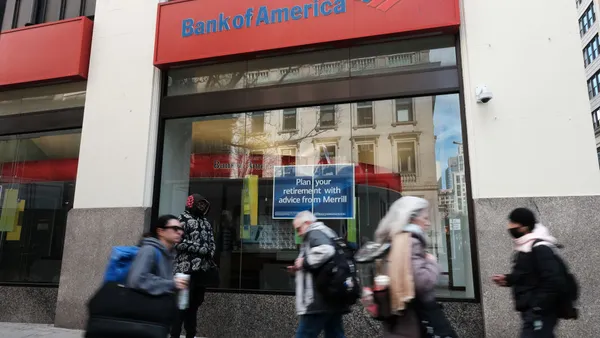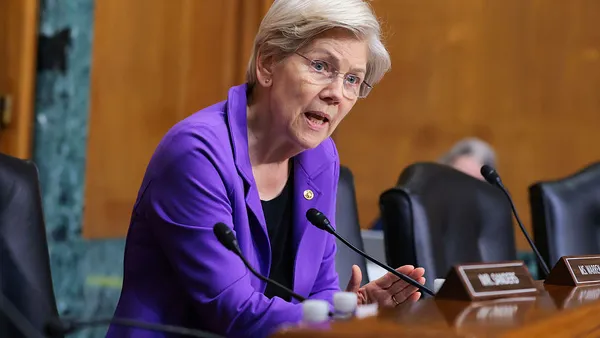Dive Brief:
- Goldman Sachs has slowed its hiring and plans to reinstate annual performance reviews, the bank’s CFO, Denis Coleman, told analysts Monday on a call to discuss the bank’s second-quarter earnings. The reviews, which have typically helped the bank cut its lowest performers at year end, were suspended “for the most part” during the COVID-19 pandemic, Coleman said, according to CNBC.
- Goldman bolstered its workforce by 15.2% over the past 12 months — counting 47,000 employees at the end of June, compared with 40,800 a year earlier, the bank reported Monday. That percentage far exceeded the 5.5% average headcount uptick seen among the six largest U.S. banks, according to Bloomberg.
- Goldman set aside 31.2% less for compensation and benefits in the first half of this year than it did in the first six months of 2021 — $7.78 billion, compared with $11.31 billion, Bloomberg reported. The bank will be “much more disciplined and focused on utilization efficiency of our human capital resources given the overall environment,” Coleman said.
Dive Insight:
Goldman’s moves come amid dwindling returns among some segments of the bank and rising fears of a coming recession.
“Given the challenging operating environment, we are closely re-examining all of our forward spending and investment plans to ensure the best use of our resources,” Coleman said Monday, according to Reuters. "Specifically, we have made the decision to slow hiring velocity and reduce certain professional fees going forward, though these actions will take some time to be reflected in our results."
The downturn in the pace of hiring extends to how quickly the bank will replace employees who leave by attrition, Coleman said. As for any reductions, no target figure exists yet, a source familiar with the matter told CNBC.
Goldman revamped its performance reviews in 2020 — revealing for the first time the breakdown of its rating system. About 25% of staff would be given an “exceeds expectations” rating. Another 65% “fully meets expectations.” And 10% will receive a “partially meets expectations” rating. The disclosure, at the time, spurred speculation as to whether the bank was considering cutting twice the 5% proportion it typically had at the end of the year.
Goldman’s headcount growth, by percentage, outpaced banks of similar size — yet not everyone is growing. Wells Fargo cut its staff by 6% from a year earlier, while Bank of America’s staff saw a 0.8% trim.
Still others insist they won’t slow down their hiring process. “You’re going to see us take a strategic look at this and a long-term look rather than just a shooting from the hip on the expenses side, because we’re building the firm for the long term here,” Citi CEO Jane Fraser said, according to The Wall Street Journal.
Executives at the bank said they expected the slowdown to be temporary. Morgan Stanley CEO James Gorman, meanwhile, said his bank has a “very clear handle” on headcount growth.
“If things really deteriorated, particularly in the U.S., then we’d take a much more aggressive position. And we obviously have the ultimate weapon, which is [compensation],” Gorman told Bloomberg.
Goldman’s CEO, David Solomon, however, appears to be taking a more skeptical stand as to how firmly the economy is pinned to a downturn.
"We see inflation deeply entrenched in the economy, and what's unusual about this particular period is that both demand and supply are being affected by exogenous events, namely the pandemic and the war on Ukraine,” Solomon said, according to CNBC. “I expect there's going to be more volatility and there's going to be more uncertainty and in light of the current environment we will manage all our resources cautiously."
Double-digit drop-offs
Coleman’s announcement came on a day when the bank reported double-digit percentage-point declines on a number of metrics.
Goldman's profit cratered 48% to $2.9 billion from $5.5 billion a year earlier. Its net revenue, meanwhile, fell 23% to $11.9 billion.
Drill deeper, and revenue in Goldman’s asset-management unit dropped 79% from last year’s second quarter. Revenue at the bank’s investment-banking division fell 41% year over year. That drop comes months after banks industrywide engaged in an all-out war for talent, and as base pay for the most junior bankers in the sphere leveled up. Still, Goldman’s decline in investment-banking revenue wasn’t nearly as steep as the 55% drop seen by Morgan Stanley, nor the 61% fall at JPMorgan Chase, according to the Financial Times.
Each of those banks, like Goldman, has set aside less for compensation — by $900 million in Morgan Stanley’s institutional securities business, and $400 million in JPMorgan’s corporate and investment bank — over the first half of 2022 than it did by the same point last year, Bloomberg reported.
Goldman’s earnings report had its bright spots, too. Revenue in the bank’s trading division jumped 32% — besting a 15% increase at JPMorgan and a 21% uptick at Morgan Stanley. On a more molecular level, Goldman saw a 55% jump in fixed-income trading.
Revenue at the bank’s consumer and wealth management unit — home to its Apple Card partnership and consumer bank Marcus — saw a 25% jump year over year. Within that, revenue at Marcus surged 67%.
Goldman added more to its reserves — $667 million — than Wells Fargo, Citi or JPMorgan Chase, which announced similar moves last week.













